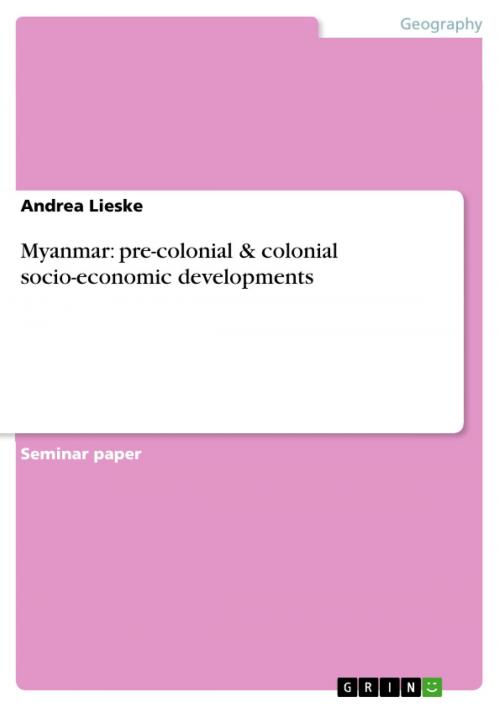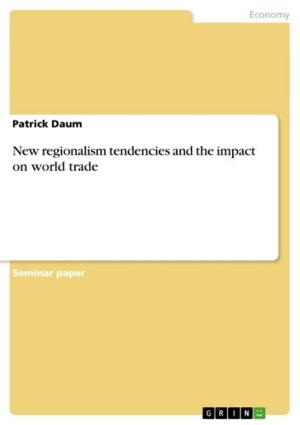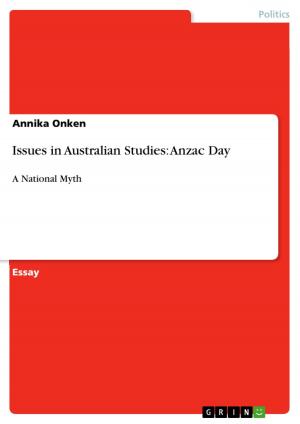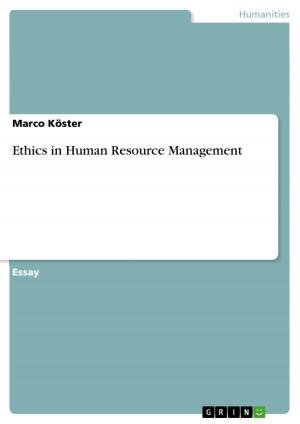Myanmar: pre-colonial & colonial socio-economic developments
Nonfiction, Social & Cultural Studies, Social Science, Human Geography| Author: | Andrea Lieske | ISBN: | 9783656029472 |
| Publisher: | GRIN Publishing | Publication: | October 17, 2011 |
| Imprint: | GRIN Publishing | Language: | English |
| Author: | Andrea Lieske |
| ISBN: | 9783656029472 |
| Publisher: | GRIN Publishing |
| Publication: | October 17, 2011 |
| Imprint: | GRIN Publishing |
| Language: | English |
Seminar paper from the year 2011 in the subject Geography / Earth Science - Regional Geography, grade: 1,0, University of Cologne (Geographisches Institut), course: Oberseminar Socio-economic developments in Myanmar, language: English, abstract: Introduction Modern-day Republic of the Union of Myanmar, formerly known as Burma, is shaped by its geographical idiosyncrasies and its history. Both factors are blended into the socio-economic developments of the country which are addressed in this paper. The focus here lies on the pre-colonial and colonial times. The names Burma and Myanmar are used equivalent and without political implications. To approximate an assessment of those two phases, it is necessary start with a short introduction to the crucial geographic and historical factors affecting the social-economic developments until 1948, the year of Myanmar's independence. The definition of the term socio-economic developments is allocated here as well. Subsequently a short overview on the most important periods of Myanmar's history is added. The following detailed description of history and socio-economic conditions and developments of three distinct periods, the Pyu city states, the Konbaung Dynasty and the British rule, enables a general view on the socio-economic developments of the time before the state's independence in 1948. This paper will proceed along one basic assumption: Independent of their time and their technological cultures all three Empires dealt with in this paper had to face the same difficulties: the scarcity of work force due to low density of population and the divide between the 'rice basket' Lower Myanmar and huge areas often depending on its supply of food in the rest of the country. Consequently the history of socio-economic development in Myanmar is hence the history of how each of the examined regimes dealt with those difficulties. Table of content Introduction 1. Geographic & historical basics of socio-economic developments until 1948 2. Overview: The history of Myanmar 3. Pyu City States (ca. 100 - 850 B.C.) 3.1. Pyu City States: Background 3.2. Pyu City states: Socio-economic conditions and developments 4. Socio-economic developments during the Konbaung Empire 4.1. Konbaung Empire: Background 4.2 Konbaung Dynasty: Socio-economic conditions and developments 5. Burma under British rule (1852 - 1948) 5.1. Burma under British rule: Background 5.2 Burma under British rule: Socio-economic conditions and developments 6. Conclusions: Socio-economic developments in Myanmar until 1948 7. Appendix 8. List of illustrations 9. Bibliography
Seminar paper from the year 2011 in the subject Geography / Earth Science - Regional Geography, grade: 1,0, University of Cologne (Geographisches Institut), course: Oberseminar Socio-economic developments in Myanmar, language: English, abstract: Introduction Modern-day Republic of the Union of Myanmar, formerly known as Burma, is shaped by its geographical idiosyncrasies and its history. Both factors are blended into the socio-economic developments of the country which are addressed in this paper. The focus here lies on the pre-colonial and colonial times. The names Burma and Myanmar are used equivalent and without political implications. To approximate an assessment of those two phases, it is necessary start with a short introduction to the crucial geographic and historical factors affecting the social-economic developments until 1948, the year of Myanmar's independence. The definition of the term socio-economic developments is allocated here as well. Subsequently a short overview on the most important periods of Myanmar's history is added. The following detailed description of history and socio-economic conditions and developments of three distinct periods, the Pyu city states, the Konbaung Dynasty and the British rule, enables a general view on the socio-economic developments of the time before the state's independence in 1948. This paper will proceed along one basic assumption: Independent of their time and their technological cultures all three Empires dealt with in this paper had to face the same difficulties: the scarcity of work force due to low density of population and the divide between the 'rice basket' Lower Myanmar and huge areas often depending on its supply of food in the rest of the country. Consequently the history of socio-economic development in Myanmar is hence the history of how each of the examined regimes dealt with those difficulties. Table of content Introduction 1. Geographic & historical basics of socio-economic developments until 1948 2. Overview: The history of Myanmar 3. Pyu City States (ca. 100 - 850 B.C.) 3.1. Pyu City States: Background 3.2. Pyu City states: Socio-economic conditions and developments 4. Socio-economic developments during the Konbaung Empire 4.1. Konbaung Empire: Background 4.2 Konbaung Dynasty: Socio-economic conditions and developments 5. Burma under British rule (1852 - 1948) 5.1. Burma under British rule: Background 5.2 Burma under British rule: Socio-economic conditions and developments 6. Conclusions: Socio-economic developments in Myanmar until 1948 7. Appendix 8. List of illustrations 9. Bibliography















